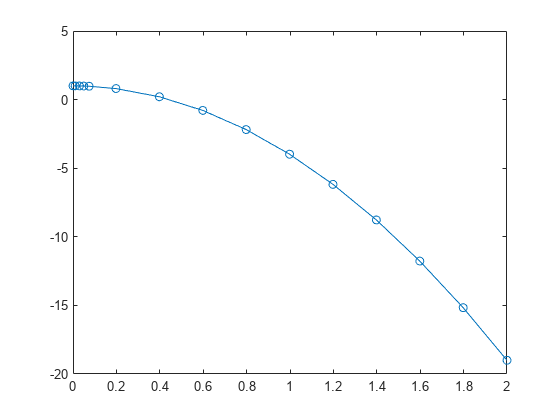ode23t
中程度にスティッフな常微分方程式 (ODE) と微分代数方程式 (DAE) の求解 — 台形則
構文
説明
[ は、t,y] = ode23t(odefun,tspan,y0)tspan = [t0 tf] のときに、初期条件 y0 を使用して、連立微分方程式 を t0 から tf まで積分します。解の配列 y の各行は、列ベクトル t に返される値に対応します。
すべての MATLAB® ODE ソルバーは、 の形式の連立方程式、あるいは質量行列 を含む問題を解くことができます。すべてのソルバーは類似した構文を使用します。ode23s ソルバーは、質量行列が定数である場合にのみ、これを含む問題を解くことができます。ode15s および ode23t は、特異質量行列をもつ方程式、つまり微分代数方程式 (DAE) を解くことができます。odeset の Mass オプションを使用して質量行列を指定します。
[ はさらに、(t,y) の関数 (イベント関数) がゼロになる点を求めます。出力の t,y,te,ye,ie] = ode23t(odefun,tspan,y0,options)te はイベント時点、ye はイベント時点における解、ie はトリガーされたイベントのインデックスです。
各関数に対して、ゼロで積分を終了するかどうかと、ゼロクロッシングの方向を考慮するかどうかを指定します。これを行うには、myEventFcn や @myEventFcn などの関数に 'Events' プロパティを設定し、対応する関数 [value,isterminal,direction] = myEventFcn(t,y) を作成します。詳細については、ODE のイベント検出を参照してください。
sol = ode23t(___)[t0 tf] の任意の点で解を計算する関数 deval で使用できる構造体を返します。前述の構文にある任意の入力引数の組み合わせが使用できます。
例
入力引数
出力引数
アルゴリズム
関数 ode23t は、"フリー" 内挿を利用して台形則を実行します。問題が中程度にスティッフであり、数値的減衰のない解が必要な場合には、ode15s よりもこのソルバーが推奨されます。ode23t は微分代数方程式 (DAE) を解くこともできます [1]、[2]。
参照
[1] Shampine, L. F., M. W. Reichelt, and J.A. Kierzenka, “Solving Index-1 DAEs in MATLAB and Simulink”, SIAM Review, Vol. 41, 1999, pp. 538–552.
[2] Shampine, L. F. and M. E. Hosea, “Analysis and Implementation of TR-BDF2,” Applied Numerical Mathematics 20, 1996.
バージョン履歴
R2006a より前に導入









